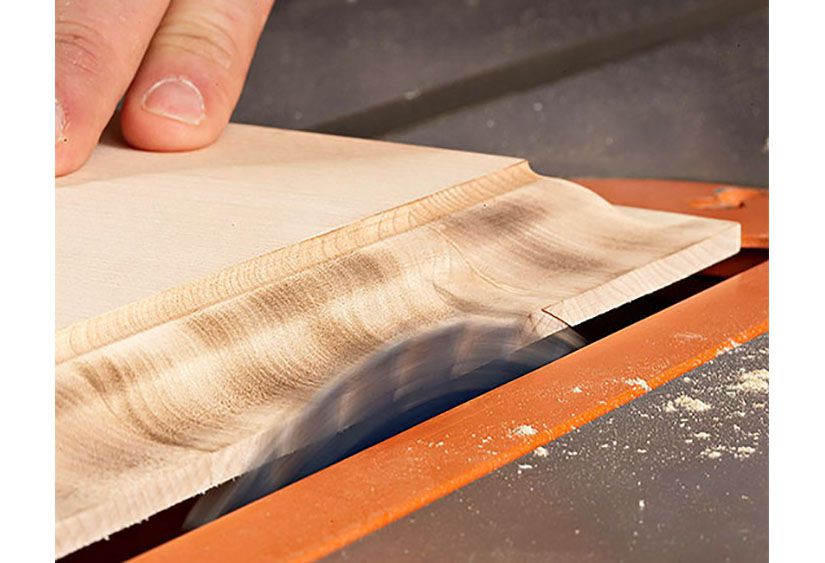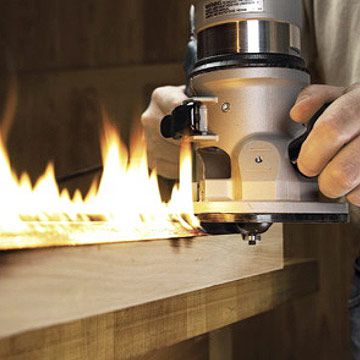Have you ever wondered why your router bit sometimes burns wood? It can be frustrating when you’re trying to create a smooth, clean cut, but instead, you end up with charred edges. In this article, we’ll explore the reasons behind this common problem and provide some insights on how to prevent it. So, let’s dive in and uncover the mystery of why router bits sometimes burn wood!
One of the main reasons why a router bit can cause wood to burn is when it overheats due to excessive friction. As the bit spins at high speeds, it generates heat, which can transfer to the wood and cause it to burn. This can happen if you’re using a dull bit, pushing the wood too slowly, or using the wrong feed rate. But don’t worry, we’ll discuss some helpful tips to avoid burning wood and achieve smooth cuts in no time!
Now that we know why router bits can burn wood, let’s explore some practical solutions. First, make sure you’re using a sharp bit that’s suitable for the type of wood you’re working with. Dull bits tend to generate more heat, increasing the chances of burning. Secondly, maintain a steady feed rate and avoid pushing the wood too slowly or forcefully against the bit. Lastly, consider reducing the router speed or using a lubricant to minimize friction and heat buildup. With these tips in mind, you can say goodbye to burnt edges and hello to flawless woodworking projects!

Why Does a Router Bit Burn Wood? Understanding the Causes and Solutions
Woodworking is a craft that requires precision and finesse. Whether you’re a professional or a hobbyist, the last thing you want is for your router bit to burn the wood you’re working on. So, why does a router bit sometimes burn wood, and what can you do to prevent it? In this article, we’ll explore the various factors that contribute to router bit burning and provide practical solutions to help you achieve clean and flawless cuts.
The Heat Factor: Understanding Router Bit Burning
The heat generated when using a router is one of the primary reasons why a router bit can burn wood. As the bit spins against the wood, friction increases, resulting in heat buildup. Excessive heat can cause the wood fibers to soften and burn, leaving undesirable marks and discoloration.
1. Improper Feeding Speed
One common cause of router bit burning is improper feeding speed. When you feed the wood into the router too slowly or too quickly, the bit is not able to efficiently remove the wood fibers, which leads to friction and burning. To avoid this, it’s crucial to find the optimal feeding speed for each type of wood and adjust accordingly. Experimenting with different speeds and monitoring the output can help you determine the correct feeding rate.
Another factor to consider is the rate at which you move the router across the wood. Moving too slowly can cause the bit to dwell in one spot, causing excessive heat buildup and burning. Conversely, moving too quickly may prevent the bit from effectively cutting through the wood, leading to burning as it struggles to remove the material. Finding the right balance between speed and smooth movement is key to preventing burning.
The Solution: Finding the Sweet Spot
To achieve the optimal feeding speed, start by making test cuts on scrap wood. Begin with a moderate speed and adjust accordingly based on the results. You’ll know you’ve found the sweet spot when the router produces clean and precise cuts without burning the wood. Remember to maintain a steady and consistent speed throughout the entire cutting process to get the best results.
2. Dull or Incorrectly Sharpened Bits
Another significant factor that can contribute to router bit burning is using dull or incorrectly sharpened bits. Over time, the cutting edges of router bits can become dull, making them less effective at cleanly cutting through the wood. Dull bits are more likely to create friction, increasing the chances of burning the wood.
Using bits that are incorrectly sharpened can also cause issues. If the cutting edges are not properly aligned or have uneven angles, they won’t be able to slice through the wood with ease. Instead, they may scrape or tear the wood fibers, leading to burning and a poor-quality finish.
The Solution: Keeping Bits Sharp and Properly Sharpened
To avoid burning caused by dull or incorrectly sharpened bits, it’s crucial to regularly inspect and maintain your router bits. Invest in a high-quality sharpening system or seek professional sharpening services to ensure your bits are properly sharpened and aligned. Keeping your bits sharp will not only prevent burning but also improve overall cutting performance.
3. Incorrect Router Speed Setting
The speed at which your router operates plays a significant role in determining whether the wood will burn or not. Using an incorrect router speed can cause the bit to spin too slowly or too fast, leading to burning.
When the router speed is too slow, the bit may not have enough cutting force, causing it to linger on the wood and generate excessive heat. On the other hand, when the speed is too fast, the bit may not have enough time to effectively remove the wood, resulting in burning as it struggles to keep up.
The Solution: Choosing the Right RPM
Choosing the correct router speed setting requires considering several factors, such as the type of wood, the bit’s diameter, and the cutting depth. Consult the router manufacturer’s guidelines and refer to charts that provide recommended speeds for different combinations of wood and bit types. By setting the router speed within the recommended range, you’ll greatly reduce the risk of burning and achieve cleaner cuts.
Conclusion: Achieving Flawless Woodworking Results
Router bit burning wood is a common problem that can easily be prevented by understanding its causes and implementing the appropriate solutions. By paying attention to factors such as feeding speed, bit sharpness, and router speed settings, you can achieve flawless woodworking results without the frustration of burnt wood. Remember to always test on scrap wood and make adjustments as needed to find the optimal settings for each project. With practice and the right techniques, you’ll be able to create clean and precise cuts that showcase the true beauty of the wood.
Key Takeaways: Why Does Router Bit Burning Wood?
- Using a dull or worn-out router bit can cause it to burn wood during routing.
- Applying too much pressure or forcing the router through the wood can lead to burning.
- High router speed combined with slow feed rate can cause wood burning.
- Using improper router bit or improper cutting technique can result in burning wood.
- Proper maintenance of the router bit, including sharpening and cleaning, is essential to prevent burning.
Frequently Asked Questions
Welcome to our FAQ section on why router bits burn wood. Below, you’ll find answers to some of the most commonly asked questions about this issue. Whether you’re a beginner or an experienced woodworker, understanding why router bits burn wood is essential to achieving clean and precise cuts. Read on to learn more!
1. What causes router bits to burn wood?
Router bits can burn wood due to various factors, such as high feed rates, inappropriate cutting speed, dull bits, or incorrect bit choice for the material. When the router bit spins too slowly or when you apply excessive pressure, it can result in excessive friction, leading to burning wood. Additionally, using worn-out or low-quality bits can increase the chances of burning wood.
To prevent burning, it’s important to ensure proper bit selection based on the material you’re working with. Using sharp, high-quality bits and maintaining an appropriate feed rate and cutting speed can also help minimize burning and achieve cleaner cuts.
2. How can I avoid burning wood with a router bit?
There are several steps you can take to prevent burning wood when using a router bit. First, make sure to choose the right type of bit for the specific material and cut you’re making. Different bits are designed for different purposes, so using the correct one can reduce the chances of burning.
Secondly, ensure that your router bit is sharp and in good condition. Dull bits are more likely to cause burning, so regular maintenance and sharpening are crucial. Proper feed rate and cutting speed are also essential. Adjusting these settings appropriately for your material and bit can help prevent burning and produce cleaner cuts. Lastly, try to reduce the amount of pressure you apply when guiding the router, as excessive pressure can increase friction and lead to burning.
3. Can the type of wood affect router bit burning?
Yes, the type of wood you’re working with can impact the likelihood of router bit burning. Certain types of wood, like hardwoods (such as oak or maple), tend to be more prone to burning due to their density and grain structure. Softwoods, on the other hand, are generally less likely to burn.
If you’re working with a dense hardwood, it’s essential to take extra precautions to prevent burning. Using a sharp bit, adjusting the cutting speed and feed rate accordingly, and applying minimal pressure can help minimize burning even when dealing with challenging wood types.
4. Is router bit burning purely a result of incorrect technique?
While incorrect technique is a common cause of router bit burning, it’s not the only factor at play. Other factors, such as using dull or low-quality bits, inappropriate bit selection, or even problems with the router itself, can contribute to burning wood. It’s important to consider all these factors when troubleshooting the issue and finding solutions.
However, mastering proper technique, such as maintaining an appropriate feed rate, controlling cutting speed, and using the correct bit pressure, is crucial in minimizing burning wood and achieving clean, smooth cuts with a router bit.
5. Can burning wood with a router bit be fixed?
If you’ve already encountered burning wood while using a router bit, don’t worry! In many cases, it is possible to fix the issue. One effective method is to sand away the burned areas gently using fine-grit sandpaper. This will help smooth out the surface and remove any burn marks.
To prevent further burning, analyze the factors that may have contributed to the issue and make the necessary adjustments. Check the cutting speed, feed rate, bit sharpness, and material compatibility. By addressing these factors and using proper technique, you can significantly reduce or eliminate burning wood with a router bit.

5 Ways to Remove Router Burn Marks – WOOD magazine
Summary
Router bit burning wood happens when the bit spins too fast or the feed rate is too slow. When the bit spins too fast, it generates more heat, leading to burning. If the feed rate is too slow, the wood stays in contact with the bit for too long, causing burning. To avoid burning, it’s important to adjust the speed and the feed rate properly.
Additionally, the type of router bit and the type of wood being used can also affect burning. Some bits are better suited for certain types of wood, so choosing the right bit is crucial. Lastly, keeping the router bit sharp and free from debris can help prevent burning as well.
In summary, to avoid router bit burning wood, make sure to adjust the speed and feed rate correctly, choose the right bit for the wood, and keep the bit sharp and clean. Happy woodworking!
